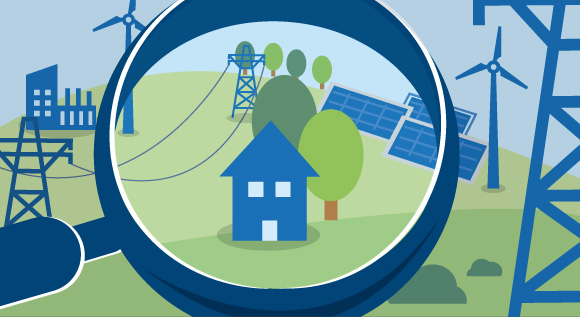What does ‘primary energy’ actually mean?
When talking about the energy transition, hardly any term is used more than that of ‘primary energy’. But what does this term actually mean?
 © BMWi
© BMWiIt’s about how much energy is provided by energy sources
More and more electricity in Germany is being generated from renewable sources of energy such as wind and solar power. In 2014, 27.4 per cent of gross energy consumption in Germany was covered by renewables. After the first half of 2015, this figure had gone on to reach 32.5 per cent. In the current year as a whole, the share of electricity generation based on renewables is set to exceed 33 per cent. But hold on a moment. Doesn’t the monitoring report on the energy transition say that in 2014, renewable energy accounted for around 11 per cent of primary energy consumption in Germany? But that’s less. What exactly is the difference – and when do we actually talk about ‘primary energy’?
Energy is more than just electricity
The answer is really quite simple. Electrical power is a form of energy – but not all of the energy we use is used in the form of electricity. Only a small share of the total energy that Germany needs is used for generating electricity. The bulk amount is used in other areas, such as heating and transport.
Let’s now consider energy as whole. When talking about the energy transition, we often use the term ‘primary energy’ or ‘final energy’. But what does this mean?
The level of energy that is naturally contained in energy sources
Primary energy is the energy content that can be drawn from a naturally occurring energy source. In other words, it is the energy that is directly available in the source – before it is converted. These include, for example, hard coal and lignite, crude oil, natural gas, as well as solar energy, wind power, hydropower, geothermal energy, and tidal energy.
This means that primary energy is contained in both fossil energy and renewables. You might call it ‘natural power’. But just because this power is there, it doesn’t mean that man can use it. This can be compared to a rough diamond that still has to be cut.
In order for power from the sun to become electricity that flows from our power sockets or heat emitted from radiators, for example, it must be converted and sometimes even transported over long distances. During this process, a certain proportion of the energy is lost. This can be thought about in the same way as the flour that is contained in bread. In order to produce this bread, you also need a certain amount of flour for rolling out the dough. This is then wiped away once the dough is ready to be baked. The complete amount of converted energy that reaches the consumer and is used to power lights, power the car, or make the home cosy, is defined as final energy. Forms of final energy include district heating and electrical power.
Primary energy consumption is falling
The Federal Government seeks to reduce primary energy consumption by a total of 20 per up to 2020 compared to the levels used in 2008. In 2014, the relevant figure fell by 5 per cent from the previous year. This decline can be largely be ascribed to the mild winter Germany had. Nevertheless, if we adjust this figure for the weather, we still arrive at a figure for primary energy consumption that is 1.6 per cent lower than in the previous year.

